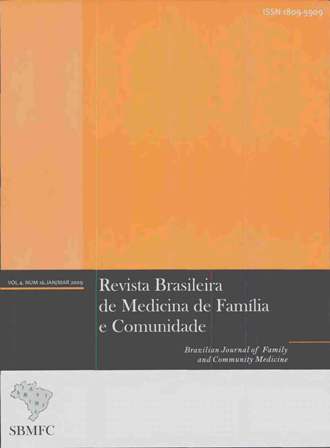Evaluation of the assistance to diabetics and or hypertenses at a Primary Health Care Unit
DOI:
https://doi.org/10.5712/rbmfc4(16)232Keywords:
Chronic Disease - Prevention and Control, Priutag Health Care, Cross-Sectional Studies, Diabetes Mellitus, ElypertensionAbstract
This paper bas the general objective to perform an evaluation of the assistance to hypertenses and/or diabetics at a health care unit of Primary Health Care, taking into account the importance of nontransmissible chronic diseases, being the cardiovascular diseases the first cause of mortality in Brazil - systemic arterial hypertension and diabetes mellitus are the main risk factors of the population, which are potentially controllable. A descriptive cross-sectional study was held, with a quantitative approach on a population of 462 hypertensive and diabetic patients, registered al the health unit of Planalto, Santa Rosa (RS); the pieces of information gathered refer to the period from September 2006 to September 2007. We noticed that, in general, structure toward care, as recommended by the Ministry of Health, is adequate. We found 431 hypertensive patients registered at the health unit, corresponding to a coverage rate of 59.6%, and 83 diabetic patients, corresponding to a coverage rate of 64.8%. The highest concentration of the registered individuals is between the age range of 50 to 69 years (56.9%). We confirmed that 87.4% of the registered patients presented one visit or more with the family and community physician (MFC); 75.5% attended on time to the date of return visit; 52.2% adhered to the treatment; 16.7% were smokers; 39.6% led a sedentary life and 49.8% were obese. The increase of the left ventricle was the most frequent complication. Metformin, hydrochlorothiazide and captopril are not being distributed to the registered patients on a regular basis. There is a lot of glibenclamide in stock. The cardiovascular high risk stratification found in this study corresponds to 23.1% by means of the British strategy and 37.3% of the American strategy, bringing to the surface the cost-benefit discussion in the treatment with the use of statins. The cardiovascular high-risk patients showing LDL cholesterol below 100mg/dl correspond to 16.3% by the British school and 12.3% by the American school, rates which are very low when compared to the American studies. We noted that the cholesterol rates are high and obesity is quite prevailing; there must be an assessment as to how the multiprofessional intervention is taking place and the adhesion and availability of statins. Finally, we highlight the importance of constant updating of the registrations at the visits, which facilitated data collection.
Downloads
Metrics
Downloads
Published
How to Cite
Issue
Section
License
By submitting a manuscript to the RBMFC, authors retain ownership of the copyright in the article, and authorize RBMFC to publish that manuscript under the Creative Commons Attribution 4.0 license and identify itself as the vehicle of its original publication.















